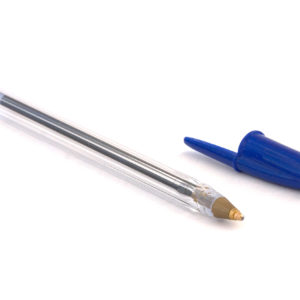10 Jun How the Ballpoint Pen Changed the World
Most people use and discard Bic Cristal ballpoint pens without a second thought as to how they came about and how they forever changed the writing style of  the world. On National Ballpoint Pen Day, lets look at this unsung hero.
the world. On National Ballpoint Pen Day, lets look at this unsung hero.
The first ballpoint pen was patented in 1888 in Massachusetts, however the idea faded and withered on the vine. Others came and went trying to perfect the pen. It was not until 1943 and an Hungarian journalist, László Bíró noticed that newspaper ink they used didn’t behave like fountain pen ink. It was thicker, didn’t smudge, and dried quicker than fountain pen ink. With a little help from his chemist brother, they transformed writing as we know it.
How did the noble ballpoint accomplish this seemingly unthinkable task? With simplicity and grace. Bíró used parts that were readily available at the time, ball bearings, quick drying ink, and roller balls. Putting these elements together for a carefully thought out purpose allowed for people to have both a mobile and reliable writing instrument. Something his first major customer, the British Royal Air Force was in dire need of.
There were some unintended consequences of making such a unique tool that includes killing off cursive. There are several factors that lead to its decline, but here is a good case set out from the Atlantic:
The ballpoint’s universal success has changed how most people experience ink. Its thicker ink was less likely to leak than that of its predecessors. For most purposes, this was a win—no more ink-stained shirts, no need for those stereotypically geeky pocket protectors. However, thicker ink also changes the physical experience of writing, not necessarily all for the better.
…A lifetime writing with the ballpoint and minor variations on the concept (gel pens, rollerballs) left me unprepared for how completely different a fountain pen would feel. Its thin ink immediately leaves a mark on paper with even the slightest, pressure-free touch to the surface. My writing suddenly grew extra lines, appearing between what used to be separate pen strokes. My hand, trained by the ballpoint, expected that lessening the pressure from the pen was enough to stop writing, but I found I had to lift it clear off the paper entirely. Once I started to adjust to this change, however, it felt like a godsend; a less-firm press on the page also meant less strain on my hand.
…In her book Teach Yourself Better Handwriting, the handwriting expert and type designer Rosemary Sassoon notes that “most of us need a flexible way of writing—fast, almost a scribble for ourselves to read, and progressively slower and more legible for other purposes.” Comparing unjoined print to joined writing, she points out that “separate letters can seldom be as fast as joined ones.” So if joined handwriting is supposed to be faster, why would I switch away from it at a time when I most needed to write quickly? Given the amount of time I spend on computers, it would be easy for an opinionated observer to count my handwriting as another victim of computer technology. But I knew script, I used it throughout high school, and I shifted away from it during the time when I was writing most.
My experience with fountain pens suggests a new answer. Perhaps it’s not digital technology that hindered my handwriting, but the technology that I was holding as I put pen to paper. Fountain pens want to connect letters. Ballpoint pens need to be convinced to write, need to be pushed into the paper rather than merely touch it. The No.2 pencils I used for math notes weren’t much of a break either, requiring pressure similar to that of a ballpoint pen.
Bíró created the ballpoint pen by combining other established, relatively commonplace technology (ball bearings & quick drying ink) with an ingenious idea to create something new. In a way, Bíró took quick drying ink and made it accessible to more people, just in a totally different application than how it had been used previously. Modern marketing has seen its own share of this, like taking seemingly abstract data about credit card purchases and using it to find patterns of behavior far beyond whether a person likes to buy wine or football equipment. What made Bíró special, and what marketers spend so much time filtering through these days, is that he used technology to solve a problem, rather than selling technology in search of a problem to solve.
Source Links
The Atlantic, How the Ballpoint Pen Killed Cursive
BBC News, Did Biros really revolutionise writing?

